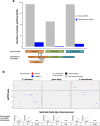Epigenome-wide association study for dilated cardiomyopathy in left ventricular heart tissue identifies putative gene sets associated with cardiac pathology and early indicators of cardiac risk
- PMID: 40057770
- PMCID: PMC11890527
- DOI: 10.1186/s13148-025-01854-8
Epigenome-wide association study for dilated cardiomyopathy in left ventricular heart tissue identifies putative gene sets associated with cardiac pathology and early indicators of cardiac risk
Abstract
Background: Methylation changes linked to dilated cardiomyopathy (DCM) affect cardiac gene expression. We investigate DCM mechanisms regulated by CpG methylation using multi-omics and causal analyses in the largest cohort of left ventricular tissues available.
Methods: We mapped DNA methylation at ~ 850,000 CpG sites, performed array-based genotyping and conducted RNA sequencing on left ventricular tissue samples from failing and non-failing hearts across two independent DCM cohorts (discovery n = 329, replication n = 85). Summary-data-based Mendelian Randomisation (SMR) was applied to explore the causal contribution of sentinel CpGs to DCM. Fine-mapping of regions surrounding sentinel CpGs revealed additional signals for cardiovascular disease risk factors. Coordinated changes across multiple CpG sites were examined using weighted gene co-expression network analysis (WGCNA).
Results: We identified 194 epigenome-wide significant CpGs associated with DCM (discovery P < 5.96E-08), enriched in active chromatin states in heart tissue. Amongst these, 32 sentinel CpGs significantly influenced the expression of 30 unique proximal genes (± 1 Mb). SMR suggested the causal contribution of two sentinel CpGs to DCM and two other sentinel CpGs to the expression of two unique proximal genes (P < 0.05). For one sentinel CpG, colocalisation analyses provided suggestive evidence for a single causal variant underlying the methylation-gene expression relationship. Fine-mapping revealed additional signals linked to cardiovascular disease-relevant traits, including creatinine levels and the Framingham Risk Score. Co-methylation modules were enriched in gene sets and transcriptional regulators related to cardiac physiological and pathological processes, as well as in transcriptional regulators whose cardiac relevance has yet to be determined.
Conclusions: Using the largest series of left ventricular tissue to date, this study investigates the causal role of cardiac methylation changes in DCM and suggests targets for experimental studies to probe DCM pathogenesis.
© 2025. The Author(s).
Conflict of interest statement
Declarations. Ethics approval and consent to participate: For each cohort, written informed consent for the research use of donated left ventricular tissue was obtained. For heart transplant recipients, consent was obtained from the transplant recipient. For brain-dead organ donors, consent was obtained from the next-of-kin. All analyses and study protocols were approved by the relevant institutional review boards. Competing interests: The authors declare no competing interests.
Figures







Similar articles
-
Epigenome-Wide Association Study Identifies Cardiac Gene Patterning and a Novel Class of Biomarkers for Heart Failure.Circulation. 2017 Oct 17;136(16):1528-1544. doi: 10.1161/CIRCULATIONAHA.117.027355. Epub 2017 Aug 24. Circulation. 2017. PMID: 28838933
-
Genomic Reorganization of Lamin-Associated Domains in Cardiac Myocytes Is Associated With Differential Gene Expression and DNA Methylation in Human Dilated Cardiomyopathy.Circ Res. 2019 Apr 12;124(8):1198-1213. doi: 10.1161/CIRCRESAHA.118.314177. Circ Res. 2019. PMID: 30739589 Free PMC article.
-
Integrative DNA methylome and transcriptome analysis identify potential genes on the influence of dilated cardiomyopathy-associated heart failure.Clin Epigenetics. 2025 Apr 28;17(1):64. doi: 10.1186/s13148-025-01876-2. Clin Epigenetics. 2025. PMID: 40296161 Free PMC article.
-
Blood-based epigenome-wide analyses of 19 common disease states: A longitudinal, population-based linked cohort study of 18,413 Scottish individuals.PLoS Med. 2023 Jul 6;20(7):e1004247. doi: 10.1371/journal.pmed.1004247. eCollection 2023 Jul. PLoS Med. 2023. PMID: 37410739 Free PMC article. Review.
-
Systematic review on the DNA methylation role in endometriosis: current evidence and perspectives.Clin Epigenetics. 2025 Feb 21;17(1):32. doi: 10.1186/s13148-025-01828-w. Clin Epigenetics. 2025. PMID: 39985111 Free PMC article.
Cited by
-
Cardiac Fibrosis in the Multi-Omics Era: Implications for Heart Failure.Circ Res. 2025 Mar 28;136(7):773-802. doi: 10.1161/CIRCRESAHA.124.325402. Epub 2025 Mar 27. Circ Res. 2025. PMID: 40146800 Free PMC article. Review.
References
-
- Reichart D, Magnussen C, Zeller T, Blankenberg S. Dilated cardiomyopathy: from epidemiologic to genetic phenotypes: a translational review of current literature. J Intern Med. 2019;286:362–72. 10.1111/joim.12944. - PubMed
-
- Cuenca S, Ruiz-Cano MJ, Gimeno-Blanes JR, Jurado A, Salas C, Gomez-Diaz I, Padron-Barthe L, Grillo JJ, Vilches C, Segovia J, et al. Genetic basis of familial dilated cardiomyopathy patients undergoing heart transplantation. J Heart Lung Transplant. 2016;35:625–35. 10.1016/j.healun.2015.12.014. - PubMed
-
- Towbin JA, Lowe AM, Colan SD, Sleeper LA, Orav EJ, Clunie S, Messere J, Cox GF, Lurie PR, Hsu D, et al. Incidence, causes, and outcomes of dilated cardiomyopathy in children. JAMA. 2006;296:1867–76. 10.1001/jama.296.15.1867. - PubMed
MeSH terms
LinkOut - more resources
Full Text Sources
Miscellaneous

